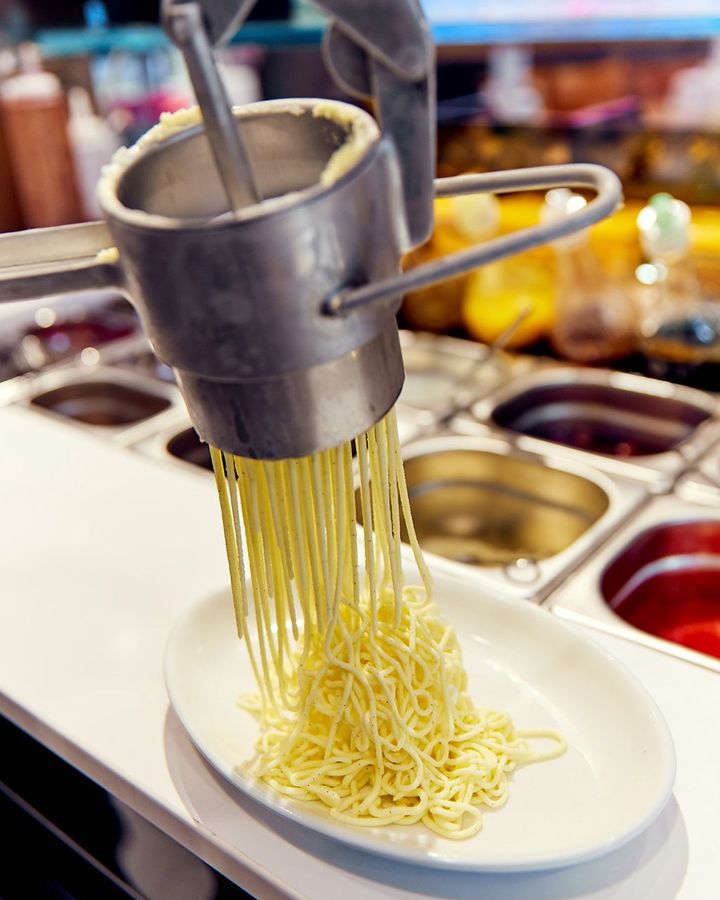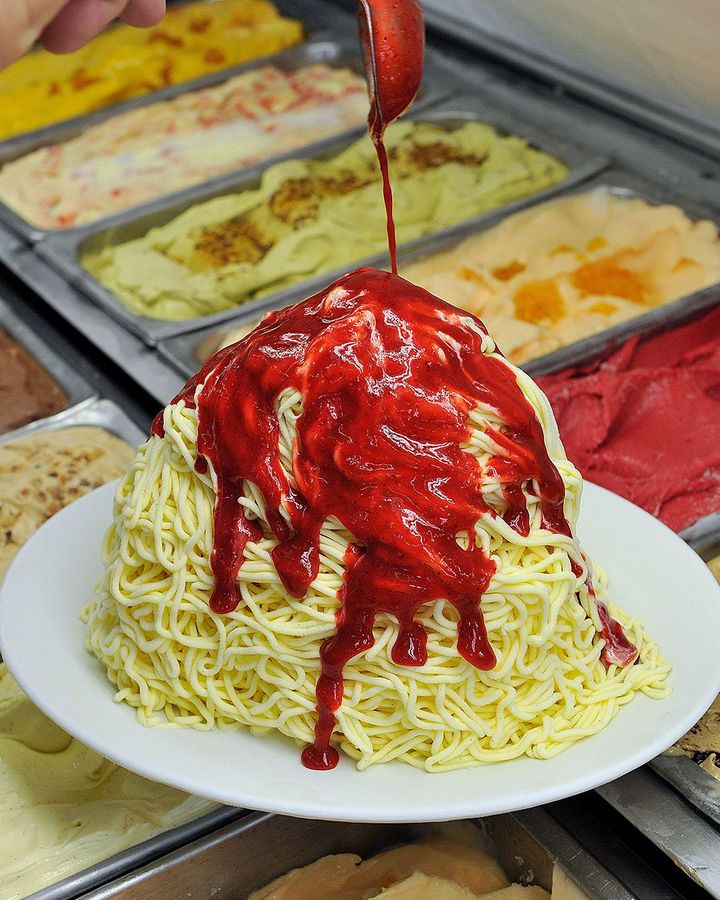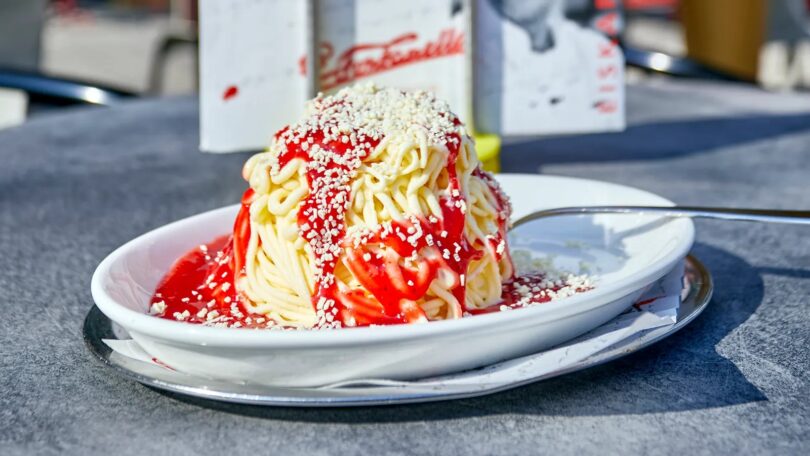At ice cream parlours around Germany, you might come across a perplexing menu item, simply labelled Spaghettieis. Eis is the German word for ice cream, and spaghetti means the same thing in German as it does in English, Italian and a host of other languages, so one may wonder what sweet-savoury concoction this could possibly be. Trying to spot Spaghettieis at someone else’s table won’t clear much up, either – from afar, the dish looks an awful lot like long, thin noodles covered in tomato sauce and a generous dusting of Parmigiano.
But get closer, and you’ll notice that the noodles seem to be melting. Spaghettieis (which is also written as Spaghetti-Eis) is a sweet, kitschy joy, prepared from vanilla ice cream or gelato pushed through a spätzle press (a tool similar to a potato ricer that is used to make German egg noodles) over a pile of whipped cream. The “noodles” are topped with strawberry sauce and grated white chocolate. This airy trick sundae is the brainchild of Dario Fontanella, the second-generation owner of Eis Fontanella Eismanufaktur Mannheim in the city of Mannheim in south-west Germany, whose goal in 1969 was to create an ice cream version of a classic Italian pasta dish.
[jump to recipe]His inspiration for the dessert’s noodles was neither German nor Italian, but French. At 17 years old, Fontanella was impressed by his first Mont Blanc, a French chestnut and cream dessert he tried at Pasticceria Embassy in the ski resort of Cortina d’Ampezzo in northern Italy. Fontanella asked the woman working behind the cafe counter how she made the dessert’s vermicelli-like strands of chestnut. “She told me it wasn’t magic, she just put chestnut purée through a potato ricer,” Fontanella said. “I immediately thought to recreate this form with my dad’s gelato [back at Eis Fontanella].”
In Mannheim, he bought a spätzle press using Easter money from his grandmother, achieving a successful noodle after figuring out that both the press and the dessert plate should both be ice cold. He made his first Spaghettieis from pistachio, lemon and strawberry gelato to represent the colours of the Italian flag. “I proudly showed it to my father, who simply commented, ‘I have never seen colourful spaghetti’,” he recollected.
Fontanella switched to vanilla, attempted to imitate a ragout from chopped raspberries – “it didn’t look pretty, though” – and prepared a strawberry purée that successfully resembled tomato sauce. The only aspect missing was Parmigiano.

To make the “noodles,” the ice cream is pushed through a spätzle press (Credit: Eis Fontanella Eismanufaktur Mannheim)
“For Easter, I was given a white chocolate Easter egg, and a piece of it grated with a cheese grater completed this new creation. It was an image for the gods,” the inventor declared. Spaghettieis went on Eis Fontanella’s menu, where it initially fooled disappointed children, whose parents ordered it for them for the first time as a surprise. “They wanted to eat ice cream and not noodles, so some got teary-eyed,” said Fontanella.
Eventually kids started catching on and embraced the fanciful dessert. After it became a hit at Eis Fontanella, the trompe l’oeil dish was slowly imitated throughout Germany. “This new specialty must have first become known by word-of-mouth,” said Fontanella. “At that time there was no social media, it just got around among colleagues [in the ice cream world],” he explained.
Tanja Rylewicz, the owner of Meine Kleine Eiszeit, an ice cream cart stationed in Berlin’s Alt-Stralau neighbourhood, recalls a lifelong fondness for the dessert. “I’ve loved Spaghettieis since I was three or four. We ate it with the whole family every weekend at the ice cream shop in the town where I was born, in Oldenburg,” she said.
Many Germans under 60 may very well break into a rapturous ode when asked about Spaghettieis, but that doesn’t mean the dessert has always been easy to find. “It was very popular when I was a young child. But then for 10 or 15 years, it was completely gone,” said Rylewicz. Eis Fontanella never stopped serving its signature creation, of course, but around the rest of the country, smaller urban outfits seemed to turn their focus onto trendy flavours like basil and salted caramel. For a while, at least, Spaghettieis was a dish you’d be more likely to find at either a long-established ice cream parlour at the edge of town, or in cities at a big cafe serving commercially made ice cream or gelato.
But Spaghettieis has been re-emerging. It’s on the menu at iconic institutions like Sarcletti, Munich’s oldest ice cream parlour, and hip Berlin locations like Rylewicz’s cart, which has no other sundae-making apparatus other than a professional Spaghettieis press screwed onto the vehicle’s tiny counter. And of course, there’s always the original, Eis Fontanella in Mannheim.

Meine Kleine Eiszeit, an ice cream cart in Berlin, serves Spaghettieis (Credit: Susannah Edelbaum)
Rylewicz estimates that over the past five years, the dessert’s prevalence on menus has been slowly growing, and at her own cart, it’s as popular as ever – at least among Germans. “The Americans are totally confused because they don’t know Spaghettieis at all,” she said, while among other Europeans, only Italians seem to know of the dish.
According to Fontanella, today 40 million servings of the sundae are sold each year at ice cream parlours and gelaterias all over the country. German supermarket chains like Rewe and Lidl carry discount Spaghettieis, and Fontanella markets his own pre-packaged creation for grocery stores under the Eis Fontanella label.
But even freezer aisle Spaghettieis from the inventor himself can never successfully mimic the dessert’s most beloved and hidden component – the freshly whipped cream, which, unusual for a sundae, goes under the ice cream instead of over it, forming little frozen nuggets that lend the dessert an unexpected airy and crispy texture.
If your local ice cream parlour has yet to invest the time and effort into pressing made-to-order Spaghettieis, you can make the fanciful treat right at home.

Spaghettieis is topped with fresh strawberry sauce (Credit: Eis Fontanella Eismanufaktur Mannheim)
Spaghettieis recipe
By Dario Fontanella
Serves 2
To make your own spaghettieis, you will need a standard spätzle press or potato ricer.
Method
Step 1
Wash and dry the spätzle press well, then put it in the freezer for around 15 minutes.
Step 2
Place the washed and hulled strawberries in a blender. Add the sugar and blend until smooth.
Step 3
Place a dollop of whipped cream on a chilled plate. Put two scoops of gelato into the spätzle press, squeeze the ice cream through the holes, and swirl it onto the plate, covering the whipped cream. Pour the strawberry sauce over the ice cream spaghetti. Grate white chocolate like Parmigiano cheese over the strawberry sauce and serve immediately.
Tip
If you have leftover sauce, it can be stored in the refrigerator for three days.
Courtesy: BBC







